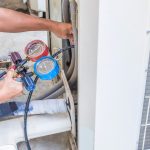Early Winter Window Condensation And Your Furnace
Another cold season is upon us. It typically coincides with the presentation of your home fighting against the cold, dry outside – as condensation on your home’s windows. But is condensation always bad? Is ice a problem? Because we often get calls about condensation at Pharo Heating, we wanted to take a quick look at Understanding Window Condensation.
Temperature always seems to be the primary determinant of winter’s arrival. First, we stop hitting 50 degrees, then 40, then…..the dreaded 30 for a high. As the air begins to cool, we often forget that it can’t hold as much moisture. Usually, this isn’t noticeable for us as we head outdoors because we grab a jacket and focus on staying warm enough until the car warms up. There’s a major change that’s happening at the same time that has to do with relative humidity.
RELATIVE HUMIDITY AND WINDOWS
Relative humidity (RH) is the amount of water in air at a certain temperature compared to the maximum amount of water that same air can hold at a certain temperature. We represent it as a percentage. Complete saturation would be 100%.
The reason this is important to the transition period in the fall/winter and winter/spring periods is that the air on the inside of the house can experience significant humidity gradients between the inside and outside a home. The humidity and temperature swing can cause condensation to occur in many situations with windows and storm doors. Usually, we see this on the bottom edge of the glass because cold air falls and creates a moisture trap with the warmer inside air. This is a similar phenomenon to condensation on a glass of ice water in the summer.
HUMIDITY CONCERNS
The major concern that most homeowners have when calling us about condensation is – Are my windows bad because I have condensation? Is there condensation elsewhere in my house that I am unaware of? We like to talk through the appearance of condensation with questions like:
- Is the condensation consistent on all windows in the home, or just in certain rooms or certain sides of home?
- Is there ice on any of the windows? Is there Ice on the glass or just window frames?
- What is the humidity in the home? In the winter it should be between 30-40%
- Do you have a whole house humidifier that isn’t regulating well?
- Do you have a whole house dehumidifier?
- Has the water started to cause mold or deteriorate the window or wall parts?
- How long have you been seeing the condensation present?
Is it the Window’s fault? (New and Old Windows)
If ice is present and you have insulated windows, you might have a bigger efficiency problem on your hands. Ice usually means the failure of any insulation value in the window or door pane. This isn’t something that has an easy fix. In some cases, you can replace the glass in the window with a replacement sash. More often, you’ll need to replace the window and frame entirely to fix the problem. Today’s replacement windows from quality manufacturers like Andersen Windows, Marvin Windows, and Sunrise Windows are designed in our climate, for our climate. The best way to see if new windows are a problem is to have a portable hygrometer near the condensation and measure the relative humidity in that area. Then look up the condenation point for the manfucaturer of the windows. If the Relative Humidity is higher than what the window will allow, then you need to reduce the humidity in the home.
Normally condensation does not accumulate on older single pane windows since they are drafty and the moisture passes right to the exterior without a barrier. That is why it is rare to see condensation in homes older than 80 years. If you see condensation on older single pane windows than the moisture is likely caused by water infiltration. Using a hygrometer in this scenario would be the best solution to pinpoint the source.
Is it the Home’s Fault? (Aprilaire and Insulation)
If you measured the Relative Humidity in several rooms and determined it to be too high, then the next likely culprit would be the Aprilaire system that many homeowners always forget about. Keep in mind that lower temperatures hold lower moisture. So one solution would be to turn the heat up so it can hold more moisture, or turn the humidifier down till the condensation goes away.
But before you turn the heat up…..better check your attic! Many homeowners do not realize that if there is major condensation on windows, there is likely condensation in your Attic. This condensation will turn to frost and then turn to mold.
Sometimes we see that the condensation is localized to bedrooms that are adjacent to bathrooms. Taking hot showers adds moisture in the air, and old fans do not expel that moisture correctly. Often the rooms we see the moisture in are cold and therefore cannot hold the moisture. Many bedrooms that are at the other end of the house where the furnace can barely keep up to temperature would see the moisture first. Sometimes lower rooms such as partially sunken dens or basements where humidity is likely to sink down to and hold (and the temperature is lower) are areas to see condensation. Solutions would include adding insulation, air sealing the home, adjusting the duct work, adding newer bath fans or running a whole home dehumidifier. With so many possibilities, a more scientific solution would be to contact a Certified Home Energy Audit Consultant. An energy audit will find areas of air and moisture infiltration using infrared scanning technology and by reversing the home’s pressure. Often there are tax incentives and local programs to improving your home’s efficiency.
If you have a large family and cannot control the humidity in your home, then it may be time for a whole home dehumidifier. Feel free to contact us today for a free in-home consultation.










